RBSE Solutions for Class 12 Maths Chapter 9 Differential Equations Ex 9.4
Rajasthan Board RBSE Solutions for Class 12 Maths Chapter 9 Differential Equations Ex 9.4 Textbook Exercise Questions and Answers.
Rajasthan Board RBSE Solutions for Class 12 Maths in Hindi Medium & English Medium are part of RBSE Solutions for Class 12. Students can also read RBSE Class 12 Maths Important Questions for exam preparation. Students can also go through RBSE Class 12 Maths Notes to understand and remember the concepts easily.
RBSE Class 12 Maths Solutions Chapter 9 Differential Equations Ex 9.4
Question 1.
\(\frac{d y}{d x}=\frac{1-\cos x}{1+\cos x}\)
Answer:
The given differential equation is:
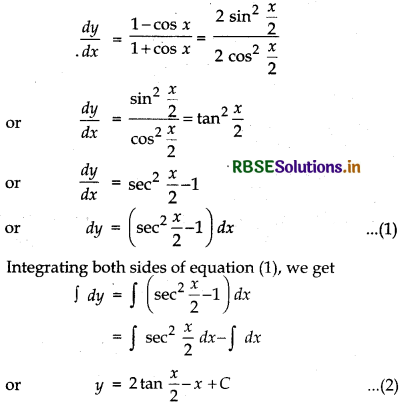
Equation (2) is the general solution of the given differential equation.

Question 2.
\(\frac{d y}{d x} = \sqrt{4-y^2}\); (- 2 < y < 2)
Answer:
The given differential equation is
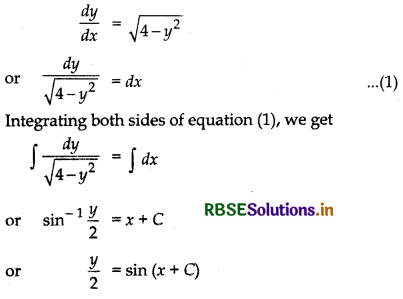
or y = 2 sin(x + C) ....... (2)
Equation (2) is the general solution of the given differential equation.
Question 3.
\(\frac{d y}{d x}\) + y = 1; (y ≠ 1).
Answer:
The given differential equation is:
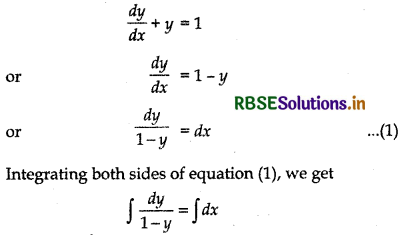
or - log |1 - y| = x + log C
⇒ x = - log C - log (1 - y)
⇒ - x = log C + log(1 - y)
⇒ - x = log C(1 - y)
⇒ C(1 - y) = e-x
⇒ 1 - y = \(\frac{e^{-x}}{C}\)
⇒ y = 1 - \(\frac{e^{-x}}{C}\)
⇒ y = 1 + Ae-x [where A = - \(\frac{1}{C}\)]
which is the required general solution of the given differential equation.

Question 4.
sec2 x tan y dx + sec2 y tan x dy = 0
Answer:
Given differential equation is
sec2 x tan y dx + sec2 y tan x dy = 0
Dividing equation (1) by tan x tan y
\(\frac{\sec ^2 x}{\tan x}\) dx + \(\frac{\sec ^2 y}{\tan y}\) dy = 0 ......(2)
Integrating equation (2), we get
∫\(\frac{\sec ^2 x}{\tan x}\) dx + ∫\(\frac{\sec ^2 y}{\tan y}\) dy = 0
or log |tan x| + log |tan y| = log C
or log |tan x tan y| = log C
or tan x tan y = C ........ (3)
(x, y ∈ R and x, y is riot the odd multiple of π/2)
Equation (3) is the required solution of given differential equation.
Question 5.
(ex + e-x)dy - (ex - e-x)dx = 0
Answer:
Given differential equation is
(ex + e-x)dy - (ex - e-x)dx = 0
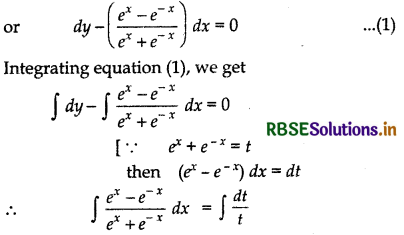
= log |t|
= log (ex + e-x)
or y - log(ex + e-x) + C = 0
or y = log (ex + e-x) + C ....... (2)
Equation (2) is the required solution of given differential equation.
Question 6.
\(\frac{d y}{d x}\) = (1 + x2) (1 + y2)
Answer:
Given differential equation is
\(\frac{d y}{d x} \)= (1 + x2) (1 + y2)
or \(\frac{d y}{1+y^2}\) = (1 + x2) dx ..... (1)
Integrating both sides of equation (1), we get
∫\(\frac{d y}{1+y^2}\) = ∫(1 + x2) dx
or tan-1 y = x + \(\frac{x^3}{3}\) + C ...... (2)
Equation (2) is the required solution of given differential equation.

Question 7.
y log y dx - x dy = 0
Answer:
Given differential equation can be written as
\(\frac{d x}{x}-\frac{d y}{y \log y}\) = 0
Integrating equation (1), we get

Equation (2) is the required solution of given differential equation.
Question 8.
x5\(\frac{d y}{d x}\) = - y5
Answer:
Given differential equation is
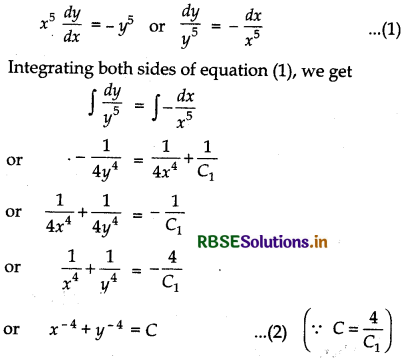
Equation (2) is the required solution of given differential equation.
Question 9.
\(\frac{d y}{d x}\) = sin-1 x
Answer:
Given differential equation is
\(\frac{d y}{d x}\) = sin-1 x
or dy = sin-1 x dx
or dy = 1.sin-1 x dx
Integrating both sides of equation (1), we get
∫dy = ∫1.sin-1 x dx
(Taking 1 as second function and sin-1 x as first function)
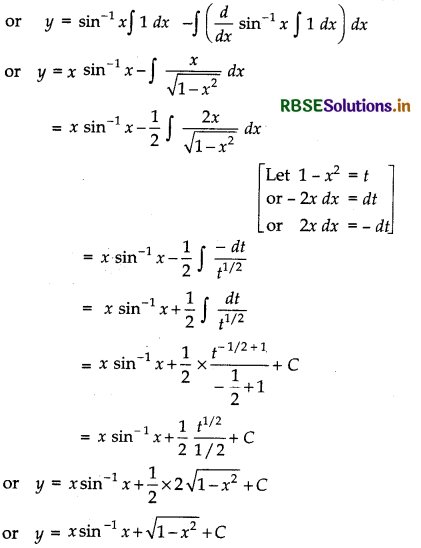
Equation (2) is the required solution of given differential equation.

Question 10.
ex tan y dx + (1 - ex) sec2 y dy = 0
Answer:
Given differential equation is
ex tan y dx + (1 - ex)sec2 y dy = 0
Dividing equation (1) by (1 - ex) tan y, we get
\(\left(\frac{e^x}{1-e^x}\right)\) dx + \(\frac{\sec ^2 y}{\tan y}\) dy = 0 .......... (2)
Integrating equation (2), we get
∫\(\frac{e^x}{1-e^x}\) dx + ∫\(\frac{\sec ^2 y}{\tan y}\) dy = 0
or - log |1 - ex| + log |tan y| = log C
[Let 1 - ex = u
or - ex dx = du
or ex dx = - du]
∴ ∫\(\frac{e^x}{1-e^x}\) = - ∫\(\frac{d u}{u}\)
= - log |u|
= - log |1 - ex|
and tan y = V
sec2 y dy = dV
∫\(\frac{\sec ^2 y}{\tan y}\) dy = ∫\(\frac{d V}{V}\)
= - log |V|
= log |tan y|
or log |tan y| = log C + log |1 - ex|
or log |tan y| = log C(1 - ex)
or tan y = C(1 - ex) ...... (3)
Equation (3) is the required solution of given differential equation.
Question 11.
(x3 + x2 + x + 1)\(\frac{d y}{d x}\) = 2x2 + x; if x = 0, y = 1
Answer:
Given differential equation is
(x3 + x2 + x + 1)\(\frac{d y}{d x}\) = 2x2 + x
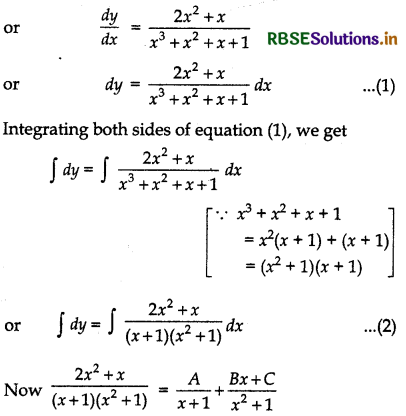
or 2x2 + x = A(x2 + 1) + (Bx + C) (x + 1)
or 2x2 + x = Ax2 + A + Bx2 + Bx + Cx + C
or 2x2 + x = (A + B)x2 + (B + C)x + A + C
On comparing the coefficients of x, x2 and constant terms of both sides, we get
A + B - 2, B + C = 1, A + C = 0
Solving these equations, we get
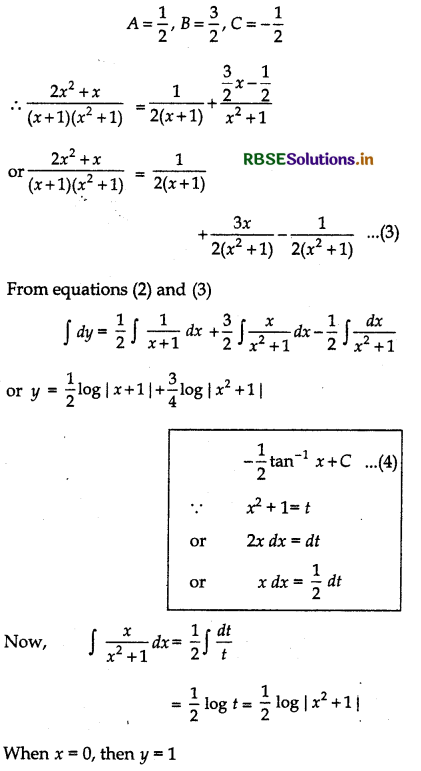
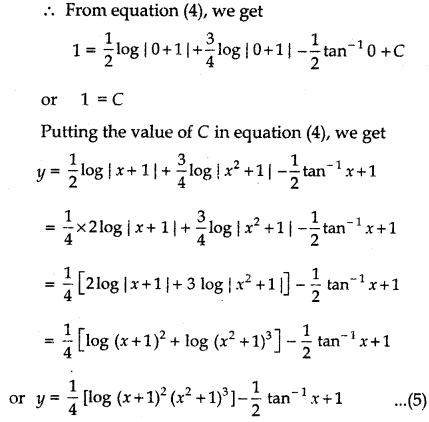
Equation (5) is the required solution of given differential equation.

Question 12.
x(x2 - 1)\(\frac{d y}{d x}\) = 1; y = 0 when x = 2
Answer:
Given differential equation is
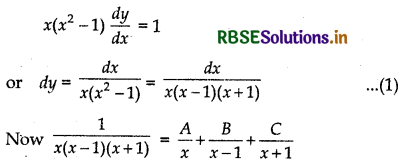
1 = A(x2 - 1) + B(x2 + x) + C(x2 - x)
or 1 = (A + B + C)x2 + (B - C)x - A
On comparing the coefficients of x, x2 and constant terms of both sides, we get
A + B + C = 0, B - C = 0, A = - 1
Solving, these equations, we get
A = - 1, B = \(\frac{1}{2}\), C = \(\frac{1}{2}\)
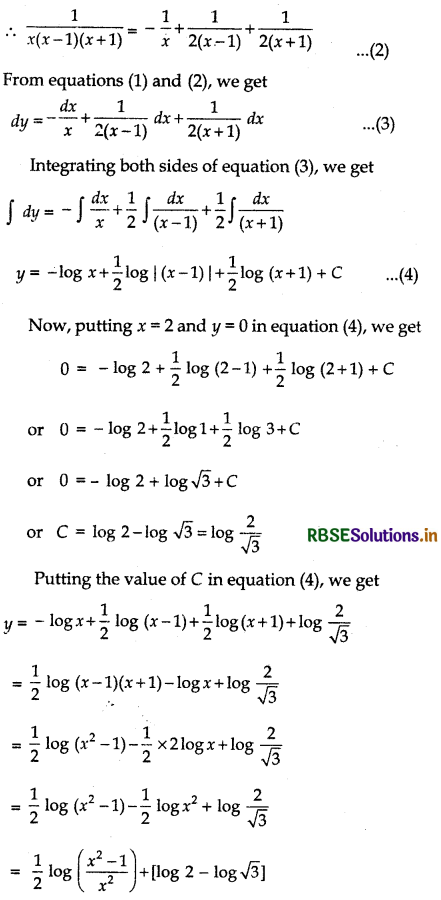
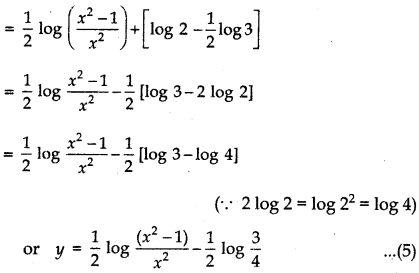
Equation (5) is the required solution of given differential equation.
Question 13.
cos \(\left(\frac{d y}{d x}\right)\) = a (a ∈ R); y = 1 when x = 0
Answer:
Given differential equation is
cos \(\left(\frac{d y}{d x}\right)\) = a
or \(\frac{d y}{d x}\) = cos-1 a
or dy = cos-1 a dx
Integrating both sides of equation (1), we get
∫dy = cos-1 a ∫dx
or y = x cos-1 a + C ..... (2)
When x = 0, then y = 1,
∴ 1 = 0 × cos-1 a + C
∴ C = 1
Putting the value C in equation (2), we get
y = x cos-1 a + 1
or y - 1 = x cos-1 a
or \(\frac{y-1}{x}\) = cos-1 a
or a = cos\(\left(\frac{y-1}{x}\right)\)
Equation (3) is the required solution of given differential equation.

Question 14.
\(\frac{d y}{d x}\) = y tan x; y = 1 if x = 0
Answer:
Given differential equations is
\(\frac{d y}{d x }\) = y tan x
or \(\frac{d y}{y}\) = tan x dx
Integrating both sides of equation (1), we get
∫\(\frac{d y}{y}\) = ∫tan x dx
or log y = - log cos x + C ... (2)
Putting x = 0 and y = 1 in equation (2), we get
log1 = - log cos 0 + C
or 0 = - log 1 + C
or 0 = 0 + C
or C = 0
Putting C = 0 in equation (2), we gc t
log y = - log cos x
or log y = - log \(\frac{1}{\sec x}\) = log sec x
or y = sec x ....... (3)
Equation (3) is the required solution of given differential equation.
Question 15.
Find the equation of a curve passing through the point (0, 0) and whose differential equation is y' = ex sin x
Answer:
Given differential equation is
y' = ex sin x
or \(\frac{d y}{d x}\) = ex sin x
or dy = ex sin x dx .............. (1)
Integrating both sides of equation (1), we get
∫dy = ∫ex sin x dx
or y = ∫ex sin x dx + C ........... (2)
Let I = ∫ex sin x dx
I = sin x ∫ex dx - ∫{\(\frac{d}{d x}\) sin ∫ex dx} dx
(Taking sin x as first function and ex as second function)
I = sin x.ex - ∫cos x ex dx
I1 = ∫ cos x ex dx
(Taking cos x as first function and ex as second function)
I = sin x ∫ex dx - ∫{\(\frac{d}{d x}\) sin ∫ex dx} dx
or I1 = cos x ex + ∫sin x ex dx ...... (4)
Putting the value of I1 in equation (3), we get
I = sin x ex - cos x ex - ∫sin x ex dx
or I = sin x ex - cos x ex - 1
or 2I = sin x ex - cos x ex
or 2I = (sin x - cos x) ex
or I = \(\frac{e^x}{2}\) (sin x - cos x)
y =\( \frac{e^x}{2}\) (sin x - cos x) + C ... (5)
Putting x = 0 and y = 0 in equation (5), we get
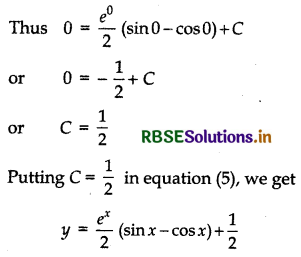
or 2y = ex (sin x - cos x) + 1
or 2y - 1 = ex(sin x - cos x)
which is the required equation of curve.

Question 16.
For the differential equation xy\(\frac{d y}{d x}\) = (x + 2) (y + 2), find the solution curve passing through the point (1, - 1).
Answer:
Given differential equation is
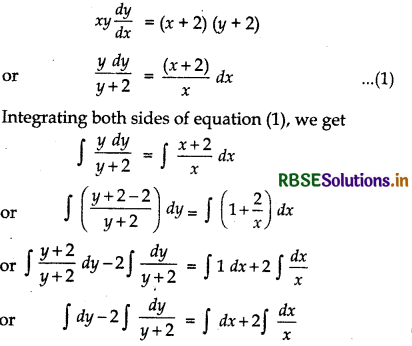
or y - 2 log |y + 2| = x + 2 log x + C
Putting x = 1, y = - 1 in equation (2)
or - 1 - 2 log |- 1 + 2| = 1 + 2 log l + C
or - 1 - 2 log 1 = 1 + 2 × 0 + C
or - 1 - 0 = 1 + C
or C = - 1 - 1 = - 2
or C = - 2
Putting the value of C in equation (2)
y - 2 log (y + 2) = x + 2 log x - 2
or y - x + 2 = 2 log x + 2 log(y +2)
or y - x + 2 = log x2 + log(y + 2)2
or y - x + 2 = log{x2 (y + 2)2}
which is the required equation of the curve.
Question 17.
Find the equation of a curve passing through the point (0, - 2) given that at any point (x, y) on the curve, the product of the slope of its tangent and y co-ordinate of the point is equal to the x co-ordinate of the point.
Answer:
The slope of the tangent of the curve at point (x, y)
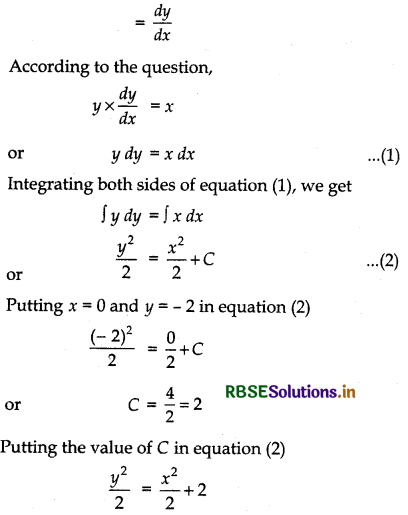
or y2 = x2 + 4
or y2 - x2 = 4 is the required equation of the curve.

Question 18.
At any point (x, y) of a curve, the slope of the tangent is twice the slope of the line segment joining the point of contact to the point (- 4, - 3). Find the equation of the curve given that it passes through point (- 2, 1).
Answer:
The slope of the tangent of the curve at point (x, y).
= \(\frac{d y}{d x}\)
The slope of the line joining the points (x, y) and

or log |y + 3| = 2 log |x + 4| + C ........ (2)
Putting x = - 2 and y = 1 in equation (2)
log |1 + 3| = 2 log |- 2 + 4| + C
or log 4 = 2 log 2 + C
or log 4 = log 4 + C
(∵ 2 log 2 = log 22 = 4)
∴ C = 0
Putting the value of C in equation (2)
log |y + 3| = 2 log |x + 4| + 0
or log (y + 3) = log (x + 4)2
or y + 3 = (x + 4)2
or (x + 4)2 = y + 3
This is the required equation of the curve.
Question 19.
The volume of spherical balloon being inflated changes at a constant rate. if initially its radius is 3 units and after 3 second it is 6 units. Find the radius of balloon after t seconds.
Answer:
Let volume of balloon at any time t is V.
According to the question
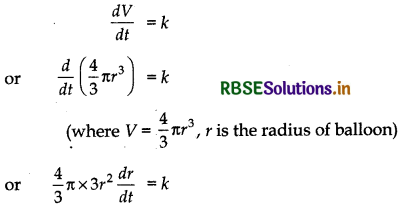
or 4πr2 dr = k dt .......... (1)
Integrating both sides of equation (1), we get
4π ∫ r2 dr = k ∫ df
or 4π × \(\frac{r^3}{3}\) = kt + C ............ (2)
When t = 0, then r = 3
∴ 4π × \(\frac{3^3}{3}\) = k × 0 + C
or 4π × 9 = C
C = 36π
Putting the value of C in equation (2)
\(\frac{4}{3}\)πr3 = kt + 36π
Again, when t = 3, then r = 6
∴ From equation (3), we get
\(\frac{4}{3}\)π × 63 = k × 3 + 36π
or \(\frac{4}{3}\)π × 6 × 6 × 6 = 3k + 36π
or 288π = 3k + 36π
or 3k = 288π - 36π
or 3k = 252π
or k = 84π
Puffing the value of k in equation (3), we get
\(\frac{4}{3}\)πr3 = 84πt + 36π
or \(\frac{r^3}{3} = \frac{4 \pi}{4 \pi}\)(21t + 9)
or r3 = 63t + 27
or r3 = 9(7t + 3)
or r = [9(7t + 3)]1/3
Hence, after t second, radius of balloon is [9(7t + 3)]1/3.

Question 20.
In a bank, principle increases continuously at the rate of r% per year. Find the value of r if ₹ 100 double itself in 10 years. (loge 2 = 0.6931)
Answer:
Let principle is P.
According to the question
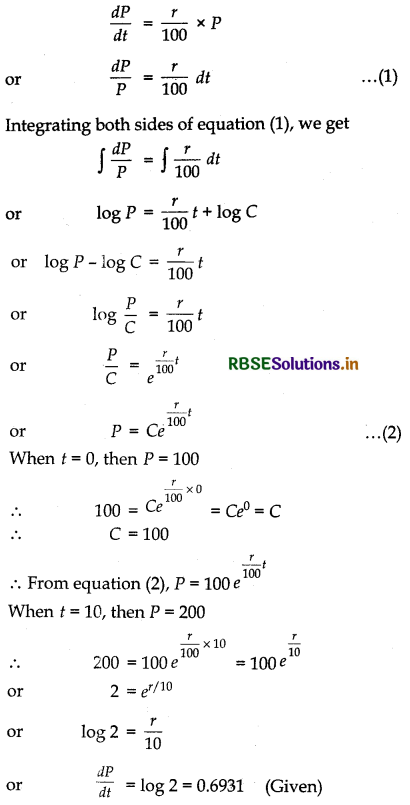
∴ r = 0.6931 × 10 = 6.931
or r = 6.93
Hence, rate of interest = 6.93%.
Question 21.
In a hank, principal increases continuously at the rate of 5% per year. An amount of ₹ 1000 is deposited with this bank, how much will it worth after 10 years. (e0.5 = 1.648)
Answer:
Let principal is P.
According to the question
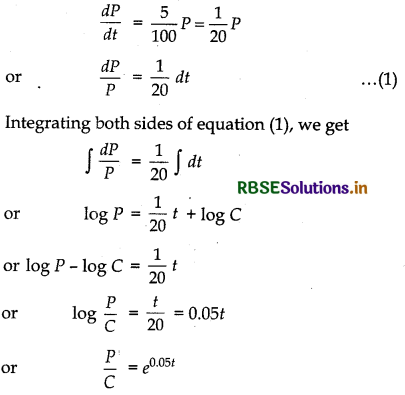
or P = Ce0.05t ..... (2)
When t = 0, then P = 1000
∴ 1000 = Ce0.05 × 0 = Ce0 = C
∴ C = 1000
∴ From equation (2), p = 100e0.05t
When t = 10 then P = 1000 0.05 × 0
= 1000e0.5
= 1000 × 1.648
∴ P = 1648
Hence, in 10, years ₹ 1,000, will be ₹ 1,648.

Question 22.
In a culture, the bacteria count is 1,00,000. The number is increased by 10% in 2 hours. In how many hours will the count reach 2,00,000, if the rate of growth of bacteria is proportional to the number present?
Answer:
Let the number of bacteria is P.
According to the question
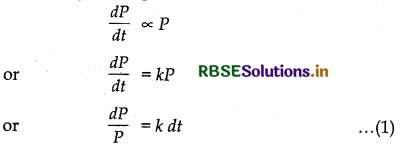
Integrating both sides of equation (1), we have
∫\(\frac{d P}{P}\) = ∫ k dt
or log P = kt + C
When t = 0, then P = P0
∴ log P0 = k × 0 + C
[Where P0 is the initial number of bacteria]
∴ C = log P0
or log P = kt + log Po
or log P - log Po = kt
or log \(\frac{P}{P_0}\) = kt ............... (2)
According to the question, bacteria increases 10% in 2 hours.
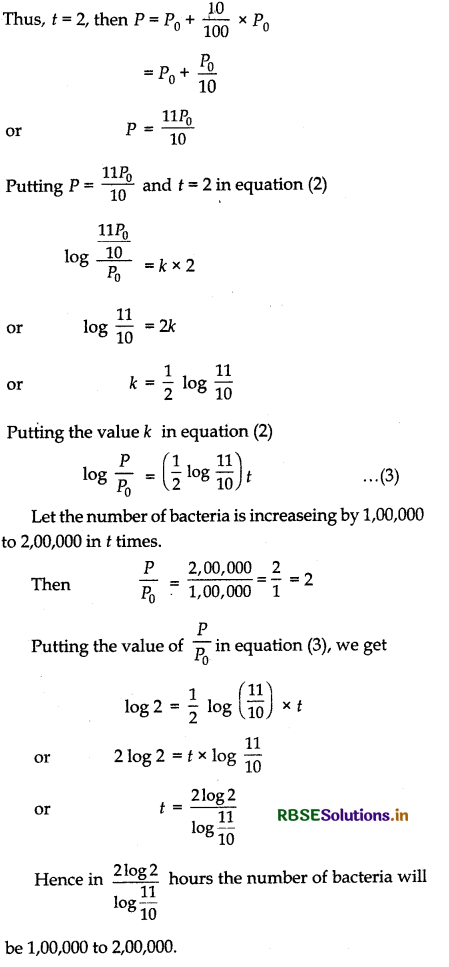

Question 23.
The general solution of the differential equation \(\frac{d y}{d x}\) = ex + y is:
(A) ex + e-y = C
(B) ex + ey = C
(C) e-x + ey = C
(D) e-x + e-y = C
Answer:
Given differential equation
\(\frac{d y}{d x}\) = ex + y = ex ey
or \(\frac{d y}{e^y}\) = ex dx
or e-y dy = ex dx
Integrating both sides of equation (1), we get
∫e-y dy = ∫ex dx
or - e- y = ex + C1
or ex + e-y = - C1
or ex + e-y = C (where - C1 = C)
Hence, option (A) is correct.

- RBSE Class 12 Maths Notes Chapter 13 Probability
- RBSE Class 12 Maths Notes Chapter 12 Linear Programming
- RBSE Class 12 Maths Notes Chapter 11 Three Dimensional Geometry
- RBSE Class 12 Maths Notes Chapter 10 Vector Algebra
- RBSE Class 12 Maths Notes Chapter 9 Differential Equations
- RBSE Class 12 Maths Notes Chapter 8 Application of Integrals
- RBSE Class 12 Maths Notes Chapter 7 Integrals
- RBSE Class 12 Maths Notes Chapter 6 Application of Derivatives
- RBSE Class 12 Maths Notes Chapter 5 Continuity and Differentiability
- RBSE Class 12 Maths Notes Chapter 4 Determinants
- RBSE Class 12 Maths Notes Chapter 3 Matrices